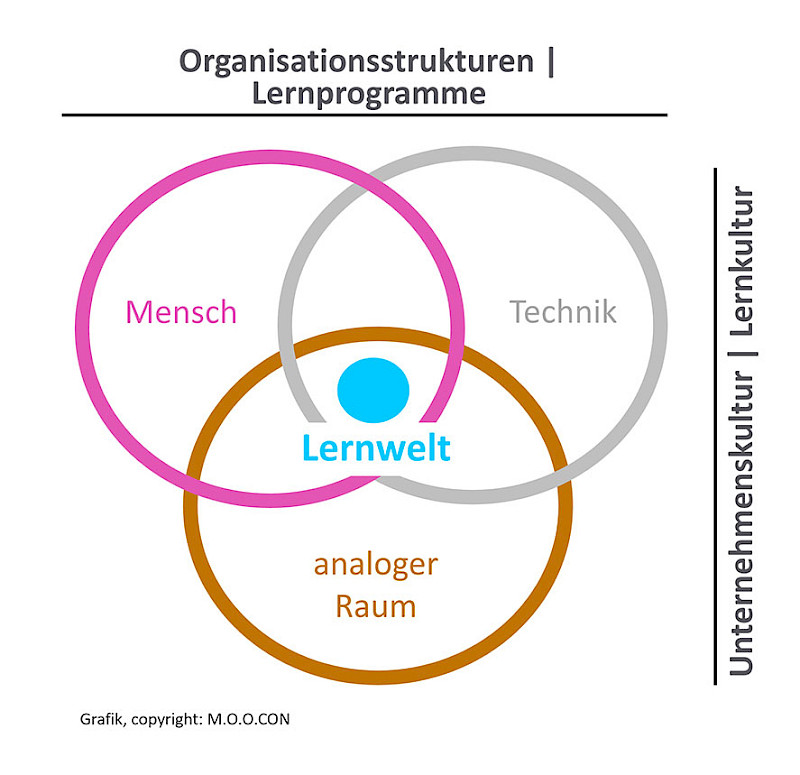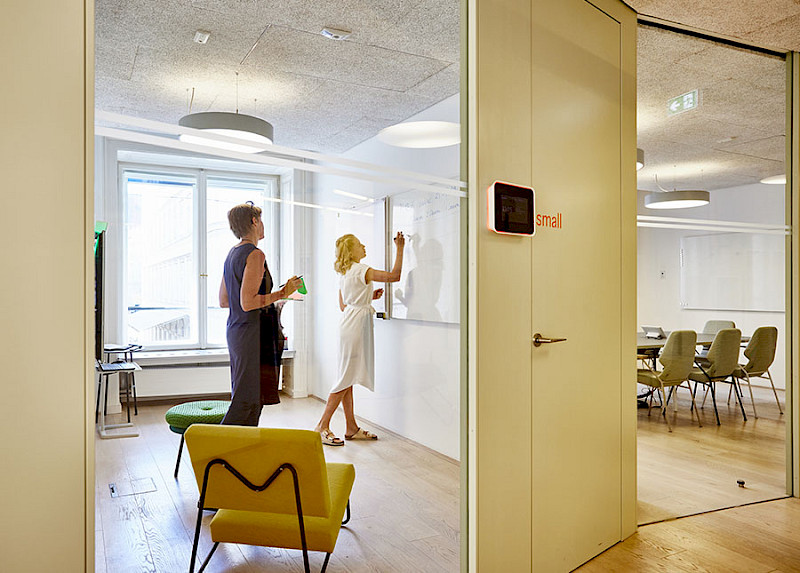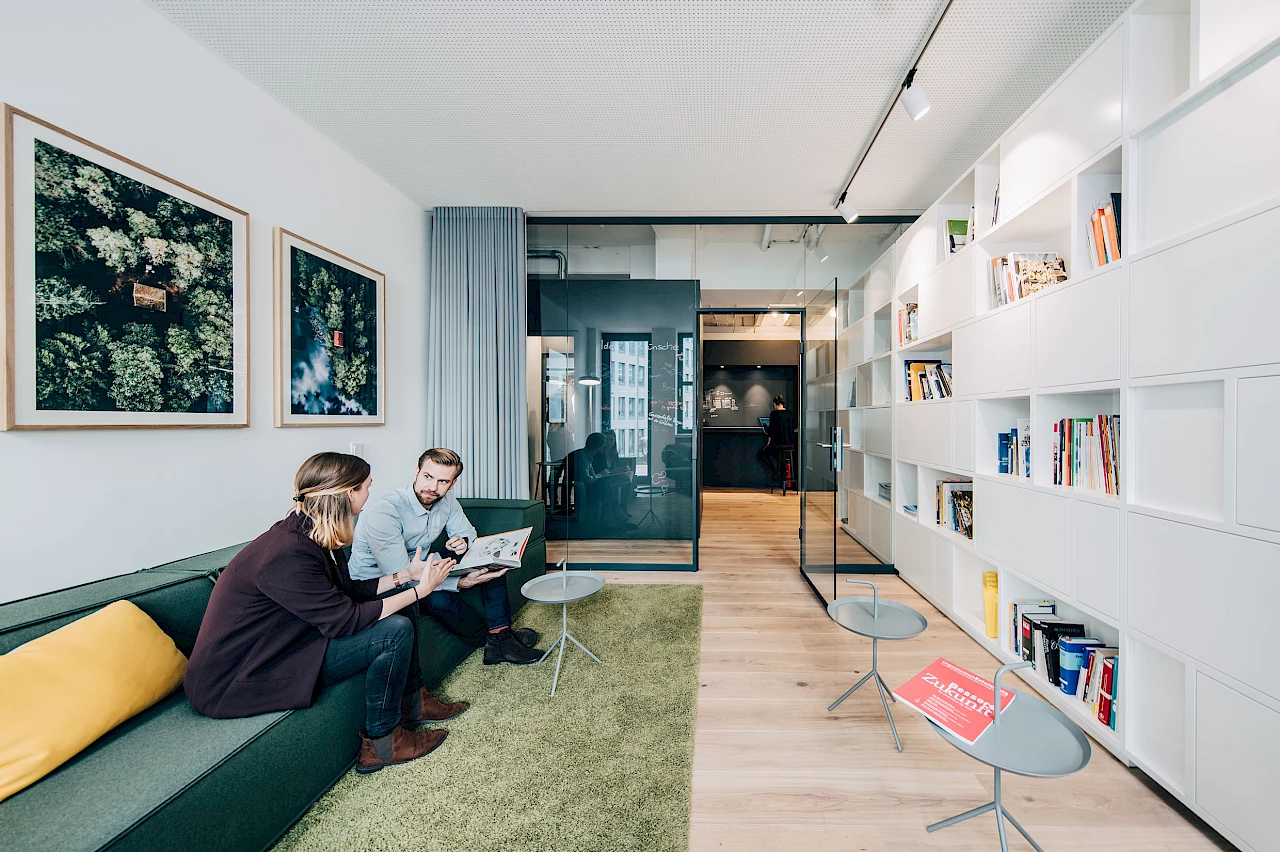THE IMPACT OF PHYSICAL SPACE
Space has an impact on human beings, whether we like it or not. This applies equally to hard-working, ambitious people and those who are easily satisfied. And to baby boomers as well as Generation Z. Many of us know that. However, only a scattering of companies and organisations are putting this knowledge to use. Although they’ve learned about the effects of space and physical proximity on people and their interaction, especially during the recent pandemic, the application of this insight has so far fallen by the wayside.
Many modern concepts of working and office space focus on typical categories of activity such as communication, focusing and individual or teamwork and provide spaces for these particular activities. For some companies, this approach is appropriate and understandable. However, an analysis of the core tasks and main activities of companies reveals that the process of learning in the course of everyday work is often overlooked or not perceived at all. In any case, it is rarely taken into account. In a knowledge-oriented work environment that is dominated by genuine experts, this failure is relevant.
COMPANIES‘ capacity for learning is an existential necessity for success
We humans learn throughout our lives, even though some of what we’ve learned disappears over time. A similar process takes place within teams, groups and entire companies. However, companies are practically forced to engage in a continuous learning process. Resting on the knowledge and skills they already have is not enough to keep a company successful. Global or regional competition, shortages of skilled workers or (disruptive) changes in the market and technical developments require that people and organisations utilize learning and the acquisition of knowledge and skills to become resilient in the face of obstacles and unwanted changes, and thus remain vital and capable of development.
The consequences and insights following the Covid-19 pandemic have been additional drivers of the development toward being a learning organisation. Many performance-oriented companies doing knowledge work suddenly had to learn how to manage work processes and interfaces remotely. For most of them, this switch was initially successful. They were able to avoid a standstill or an abrupt end of their business operations. In many cases, the switch even led to increases in productivity; for most companies, this was unexpected. However, today companies must learn how to deal with the consequences of remote work — in simple terms, with working from home. Avoiding social and cultural cutbacks, maintaining valuable interpersonal communication and promoting employees’ loyalty to the company are seen as the most critical challenges for business success.
work and learning in the office are merging
Finally, companies are facing urgent questions: What can they do in order to ensure that employees are learning from one another and sharing the most valuable corporate knowledge? How can continuous learning be developed and expertise be transferred within a company? The dominance of a learning culture that can always be felt and experienced is considered a basic requirement for the development of individuals, groups and the organisation as a whole. Learning, personal development, critical thinking and tolerance for errors should be part of the DNA of a company that is willing to evolve.
In addition, other approaches to learning that are embedded in the corporate structure are necessary and must be systematically implemented. Alongside new methods — such as microlearning and gamification, among many others — and digital space, analogue space is attracting more and more attention from chief learning officers, organizational developers and HR managers as a factor supporting the learning process. It’s all too obvious that space has a huge impact on our thought processes, emotions and awareness, which in turn are crucial for our learning behaviour and creative power.

Analogue Learning space: a tool with real potential impact
Companies that offer their employees an analogue learning environment in addition to a traditional office area as a place of work are ensuring there is a high degree of spatial diversity that expresses the company’s open spirit and thirst for innovation, while appealing to the emotions. The functional and atmospheric diversity of an effective learning environment offers space for a variety of learning venues with their typical characteristics. Examples include settings for verbal communication and focusing, for cooperative and individualised learning, analogue and digital tools, experimental and manual approaches, serious and amusing features — offers that are available to all learners at any time. Ideally, these can be combined in line with a company’s specific needs and arranged flexibly.
Equally relevant is the provision of spaces suitable for the different phases of learning we undergo. Just as in sports training, individually structured and scheduled breaks are important for cognitive training as well. Such breaks require supplementary areas for peace and quiet, along with the opportunity to choose one’s own place for learning and regeneration. The absence of attractive places for regeneration and breaks can interfere with the development of a positive learning atmosphere (here readers might recall their own experiences in school or at university. Incidentally, colleges and universities are also facing the challenge of offering suitable learning areas!).
Thus analogue space can be used as a tool for learning that enables people to enter a mood in which they are ready to learn and deal with thematic issues (but be careful: individuals should genuinely want this for themselves. A learning programme that is imposed on people is not enough!). All of the qualities that can characterise a space — from proportions, size and height to light and lighting, the quality of ventilation and acoustics, functionality and materiality — serve in the creation of an effective analogue space.

Sightlines between learning venues support a “we’re learning” mentality. Private spaces encourage users to think boldly and freely, try things out and deviate from previously learned pathways. Workbenches promote hands-on learning by doing, and surfaces that can be written on invite people to sketch out their ideas. The provision of professional services for the learning venue expresses appreciation.
absolutely!
Learning venues are profit-makers for all companies in the knowledge society. If companies successfully create equally attractive learning venues within their own four (office) walls, generate incentives for the shared and individual use of these venues, and implement a culture of learning with and from one another, they can exploit the potential knowledge and skills that exist inside their own organisation. Added value and corporate development grow together — when they are wanted, tested and put into practice by a company.
Please also read

Tobias Baur is a partner and senior consultant at M.O.O.CON. He works with customers and at their premises to develop meaningful and sustainable real estate strategies, conceive and implement work environments and design projects. For further information, visit https://www.moo-con.com/.
Photos: M.O.O.CON




 Tobias Baur
Tobias Baur 
